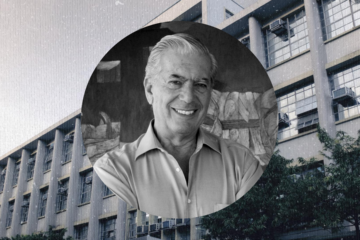WHEN THE ordinary human hand grants vision to the blind, heals the flesh of the wounded and gives hope to the hopeless, all skepticism seems to fly out of the window.
In 1982, many were left pondering whether miracles exist when Himala, regarded as one of the greatest, if not the greatest, Filipino films, was shown and turned screenwriter Ricardo Lee, the late director Ishmael Bernal and actress Nora Aunor into icons.
More than four decades later, movie goers are again invited to examine their belief and unbelief with Pepe Diokno’s rendition of the classic – one with its own artistic flair too compelling that it almost feels like an actual miracle sprouted from the rather oversaturated 50th Metro Manila Film Festival (MMFF) lineup.
Released on Dec. 25, Isang Himala is a musical rendition of Himala. Through Bernal’s and Lee’s craft, director Diokno does not reimagine a classic but rather breathes more life into the story that has long been considered as one that defines the golden age of Philippine cinema.
The MMFF entry makes itself clear through the obvious theme of blind belief. Audiences would be familiar with Isang Himala’s subject through their knowledge of the 1982 film as the commonality takes viewers back to a time of excessive reliance on the divine.
Elsa (Aicelle Santos) presents viewers with a familiar scenario: a kneeling maiden in front of a small ray of light that made her stood out in the darkness, an indication of her supposed encounter with the Virgin Mary and a symbol of her newfound healing power.

The film opens with an eclipse over the backward barrio of Cupang, whose inhabitants believe they have been cursed because of their refusal to help a leper who had visited them. All guilt is washed away when they learn of Elsa’s miraculous works, as they believe that it is the Divine’s way of absolving them from their gravest sin.
The film’s musical genre takes advantage of the dramatic turn of events throughout Cupang, intensifying the tension through performances of original songs of what would have been casual exchanges among the characters. However, the film, whose running time is more than two hours, featured conversations and songs that were not really essential to the story, such as that of Elsa’s close friend-turned-assistant Chayong (Neomi Gonzales) and his boyfriend Pilo (Vic Robinson), who is indifferent to the unexplainable healings taking place in the town.
One of the film’s more poignant themes was presented by Nimia (Kakki Teodoro) through her elaborate display of contrast between her and Elsa’s fates. Elsa performs miracles and manifests traits that resemble that of the Virgin Mary; Nimia demonstrates a daring and devil-may-care persona who ends up working as a prostitute.
Nimia, explicitly seen as the outlier in her clique with Elsa and her other childhood friend Chayong, makes her own version of miracles clear to the viewers. As a sex worker, her reputation contrasts Elsa’s pious image.
But both of them enjoy the patronage of local residents in different ways. Many of Elsa’s devotees avail of the “miracles” offered by Nimia’s cabaret by night, undoing the virtuous work they do by day.
Nimia’s characteristic solo in her cabaret bar that contained the lines “ang tunay na himala ay nasa gitna ng aming mga hita (the true miracle is in between our thighs)” and “ako ang tunay na birhen na sa lahat nagpapakita (I’m the true virgin who shows herself to everyone),” established her contempt for Elsa’s narratives, a creative way of describing the taboo through words associated with the divine.
Throughout the film, it is clear that the contrast runs deep among the people of Cupang as they seek refuge in two disparate miracles from opposing moral forces.

Elsa’s and Nimia’s contrast, no matter how real or grim they were, drove Cupang to strip itself of its thin veil of purity, only held in place by hearsays and the belief in what the human mind cannot fathom. The more Elsa performed miracles, the less receptive her devotees became to the verifiable truths around them. This can be observed in a scene where Sepa (Joann Co), one of Elsa’s devotees, refuses to bring her ailing child to the doctor, as she believes that Elsa’s faith will be enough to cure her child of sickness he contracted after eating infected food.
This overreliance on Elsa’s miracles is one of the other potent messages that both the 1982 and 2024 films want viewers to internalize, for what follows is the burden of a consequence that Sepa will have to carry for the rest of her life; it is an indication of the dangers of the full control of blind fanaticism.
As the film progresses, it is clear that the people have gone beyond their fascination with Elsa’s miracles, as Elsa herself has now become the emblem of what they have long believed in. In one of the scenes, a devotee even called Elsa a “saint.” This is where Cupang’s unsettling calm unveils itself, revealing the impurity that eventually trumps the mystique brought upon by Elsa’s miracles.

Diokno stayed close to Bernal’s 1982 craft, complete with the iconic ‘Elsa loves you,’ tarpaulin draped across her hill of miracles. Isang Himala’s flow, from the appearance of a solar eclipse to Elsa’s misfortunes, allowed the story of the original to come back to life, this time through the remarkable performances of Aicelle Santos, Kakkie Teodoro and Neomi Gonzales as estranged friends; David Ezra as Orly, the atheist filmmaker who documented Elsa’s activities; and Bituin Escalante as Aling Saling, Elsa’s apprehensive adoptive mother.
The film’s beauty does not rely on its faithfulness to the original film. Until the very end, Isang Himala showcases what sets itself apart from the 1982 classic.
Members of the cast lived up to their identities as musical theatre actors. Santos’ second time being Elsa proved to be an advantage to the film’s emotional delivery, as her strong vocals evoked the mystique and vulnerability expected from someone drawing her supposed power from the Virgin Mary. More of her presence took center stage in the film’s latter half, a presence characterized by guilt, shame and regret from her flailing responsibilities as the barrio’s ever-reliable faith healer.
Much of Isang Himala’s visuals also stayed close to the original–from Elsa’s everyday attire to the white dress she wears while at work on the hills of Cupang. Its setting did reflect that of the 1982 film, yet this might be where the film falters a bit.
The houses and hills of the 2024 Cupang carry a dreamlike trait to them, almost as if they would be more suited as a backdrop for a theatre performance than being a part of the film. The set itself presented itself more as a caricature of the 1982 Cupang, therefore evoking an artificial feeling.
The setting looks cramped for a supposedly far-flung barrio. The chapel, a witness to key revelations by a number of characters, is just an ordinary hut with a confessional.
This style employed by production designer Ericson Navarro best served the musical genre of the film. A realistic set design, however, could have been more of a tool for the intense occurrences throughout the film. The vastness of Elsa’s barrio in the 1982 version allowed viewers to feel a sense of isolation, a key element in Himala’s enigmatic identity that is absent in Isang Himala.

Isang Himala did not stray at all from Bernal and Lee’s original craft. If anything, the musical further bolstered the pressing message of the 1982 film, and how harmful blind fanaticism can truly be.
Today, both Himala’s and Isang Himala’s themes hit closer than ever, especially to those who blame curses for their misfortunes and who seek miracles and charismatic personas to free themselves from the consequences of their own actions. F



